Discover 35 hidden attractions, cool sights, and unusual things to do in Boston (United States). Don't miss out on these must-see attractions: Museum of Fine Arts, Quincy Market, and Faneuil Hall. Also, be sure to include Old State House in your itinerary.
Below, you can find the list of the most amazing places you should visit in Boston (Massachusetts).
Table of Contents
Museum of Fine Arts
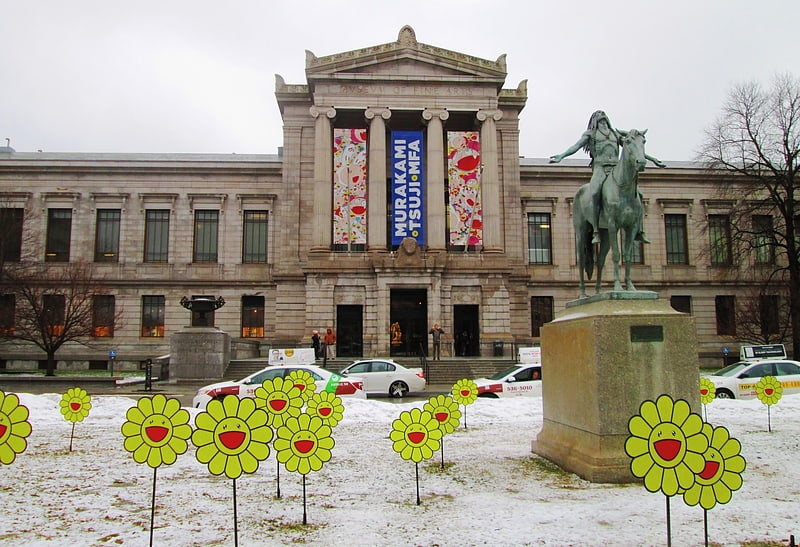
Impressionist art and Egyptian treasures. The Museum of Fine Arts is an art museum in Boston, Massachusetts. It is the 20th-largest art museum in the world, measured by public gallery area. It contains 8,161 paintings and more than 450,000 works of art, making it one of the most comprehensive collections in the Americas. With more than 1.2 million visitors a year, it is the 52nd–most visited art museum in the world as of 2019.
Founded in 1870 in Copley Square, the museum moved to its current Fenway location in 1909. It is affiliated with the School of the Museum of Fine Arts at Tufts.[1]
Address: 465 Huntington Ave, 02115 Boston
Quincy Market
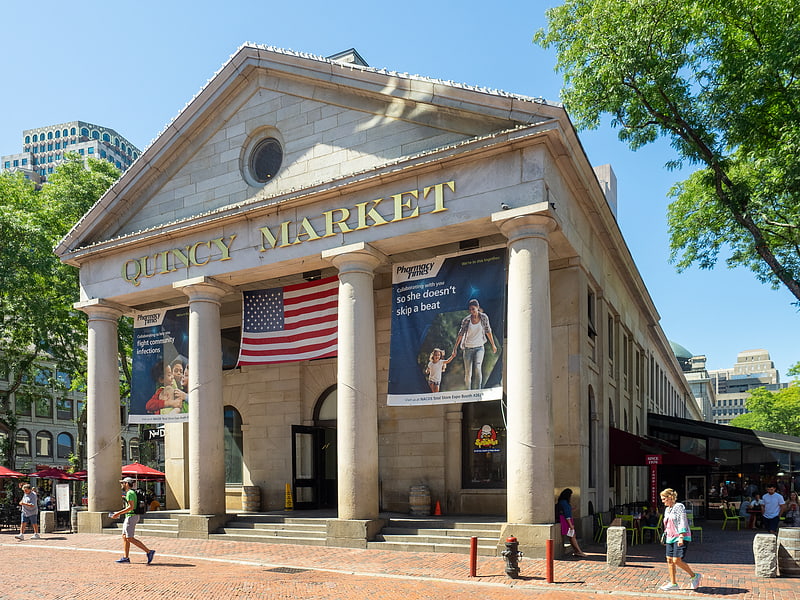
Marketplace in Boston, Massachusetts. Quincy Market is a historic building near Faneuil Hall in downtown Boston, Massachusetts. It was constructed in 1824–26 and named in honor of Mayor Josiah Quincy, who organized its construction without any tax or debt. The market is a designated National Historic Landmark and a designated Boston Landmark in 1996, significant as one of the largest market complexes built in the United States in the first half of the 19th century.
As the central building of Faneuil Hall Marketplace, Quincy Market is often used metonymically for the entire development. By the mid-20th century it was badly in need of repair, and it was redeveloped into a public shopping and restaurant area in the early 1970s and re-opened in 1976. Today, this includes the original Quincy Market buildings, the later North Market and South Market buildings that flank the main Quincy Market, the historic Faneuil Hall lying at the west end, and two smaller curved buildings, added later to the east end.[2]
Address: 4 S Market St, 02109-6201 Boston
Faneuil Hall
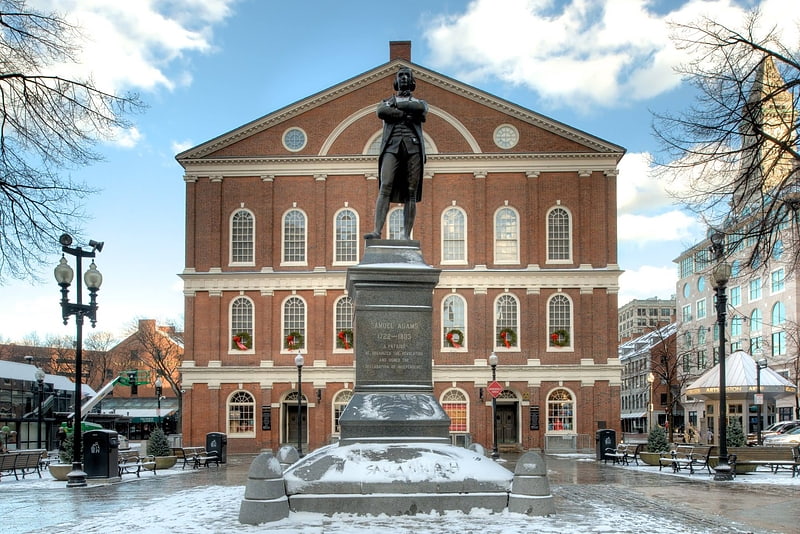
Historic indoor-outdoor shopping center. Faneuil Hall is a marketplace and meeting hall located near the waterfront and today's Government Center, in Boston, Massachusetts. Opened in 1743, it was the site of several speeches by Samuel Adams, James Otis, and others encouraging independence from Great Britain. It is now part of Boston National Historical Park and a well-known stop on the Freedom Trail. It is sometimes referred to as "the Cradle of Liberty".
In 2008, Faneuil Hall was rated number 4 in "America's 25 Most Visited Tourist Sites" by Forbes Traveler.[3]
Address: 4 S Market St, 02109 Boston
Old State House

Original colonial seat and state capitol. The Old State House is a historic building in Boston, Massachusetts. Built in 1713, it was the seat of the Massachusetts General Court until 1798. It is located at the intersection of Washington and State Streets, and is one of the oldest public buildings in the United States.
One of the landmarks on Boston's Freedom Trail, it is the oldest surviving public building in Boston, and now serves as a history museum that, through 2019, was operated by the Bostonian Society until January 2020. On January 1, 2020, the Bostonian Society merged with the Old South Association in Boston to form Revolutionary Spaces. The Old State House was designated a National Historic Landmark in 1960 and a Boston Landmark by the Boston Landmarks Commission in 1994.[4]
Address: 206 Washington St, 02109 Boston
Museum of Science
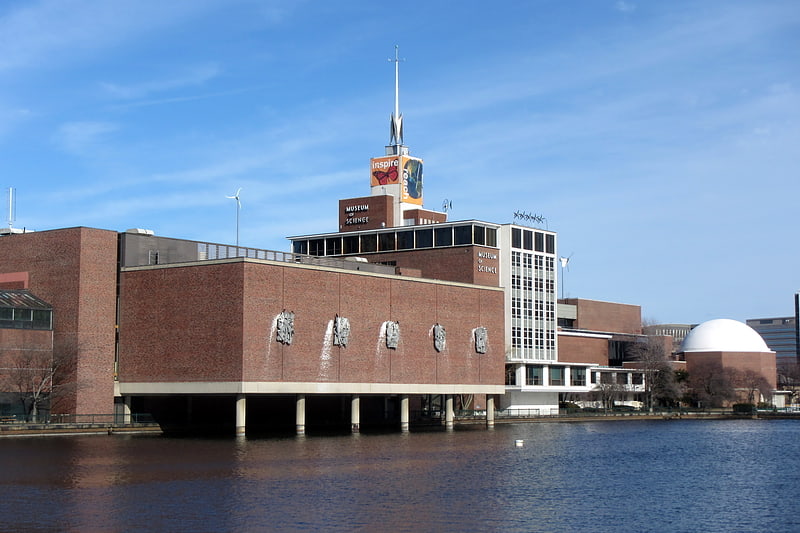
Interactive exhibits and an IMAX theater. The Museum of Science is a science museum and indoor zoo in Boston, Massachusetts, located in Science Park, a plot of land spanning the Charles River. Along with over 700 interactive exhibits, the museum features a number of live presentations throughout the building every day, along with shows at the Charles Hayden Planetarium and the Mugar Omni Theater, the only domed IMAX screen in New England. The museum is also an accredited member of the Association of Zoos and Aquariums and is home to over 100 animals, many of which have been rescued and rehabilitated.[5]
Address: Museum Of Science Driveway, 02114 Boston
Boston Common
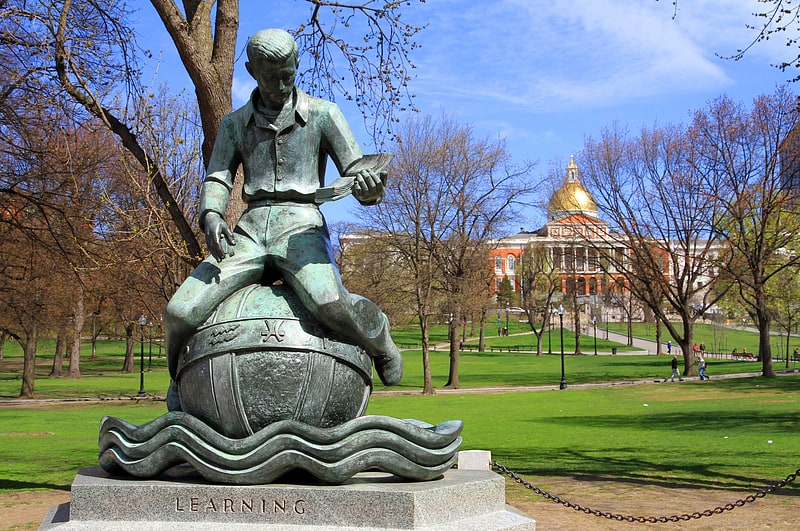
Venerable park with historic cred. The Boston Common is a central public park in downtown Boston, Massachusetts. It is sometimes erroneously called the Boston Commons. Dating from 1634, it is the oldest city park in the United States. The Boston Common consists of 50 acres of land bounded by Tremont Street, Park Street, Beacon Street, Charles Street, and Boylston Street. The Common is part of the Emerald Necklace of parks and parkways that extend from the Common south to Franklin Park in Jamaica Plain, Roxbury, and Dorchester. A visitors' center for all of Boston is on the Tremont Street side of the park.
The Central Burying Ground is on the Boylston Street side of Boston Common and contains the Graves of the artist Gilbert Stuart and the composer William Billings. Also buried there are Samuel Sprague and his son, Charles Sprague, one of America's earliest poets. Samuel Sprague was a participant in the Boston Tea Party and fought in the Revolutionary War. The Common was designated as a Boston Landmark by the Boston Landmarks Commission in 1977.[6]
Address: 139 Tremont St, 02111 Boston
New England Aquarium
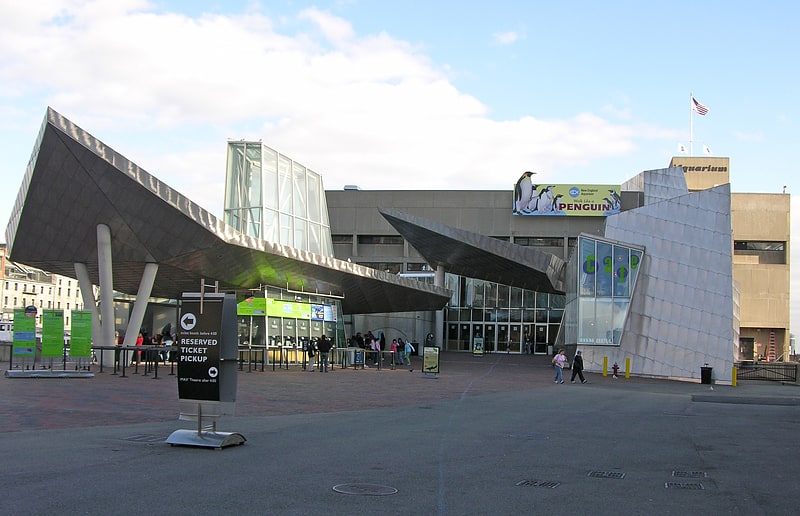
Aquarium in Boston, Massachusetts. The New England Aquarium is a public aquarium located in Boston, Massachusetts. In addition to the main aquarium building, attractions at the New England Aquarium include the Simons Theatre and the New England Aquarium Whale Watch, which operates from April through November. The aquarium has more than 22,000 members and hosts more than 1.3 million visitors each year.[7]
Address: 1 Central Wharf, 02110 Boston
Metropolitan Waterworks Museum
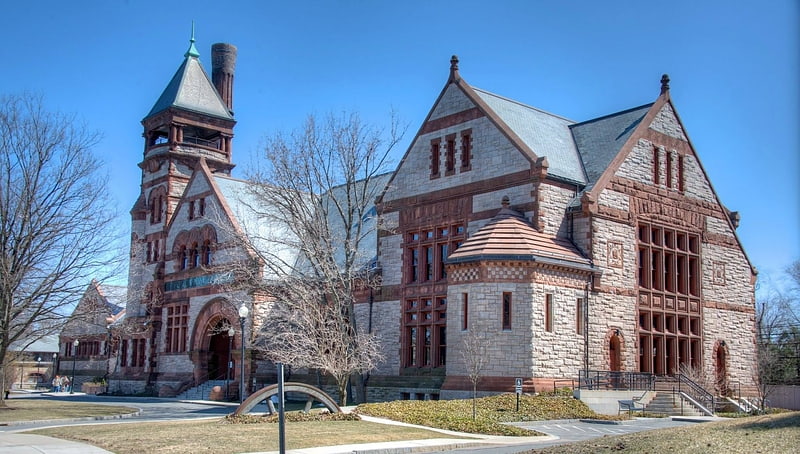
Museum in Boston, Massachusetts. The Waterworks Museum is a museum in the Chestnut Hill Waterworks building, originally a high-service pumping station of the Boston Metropolitan Waterworks. It contains well-preserved mechanical engineering devices in a Richardsonian Romanesque building.
During its busiest years, the waterworks pumped as much as a hundred million gallons of water each day. The station was decommissioned in the 1970s, and later some of its buildings were turned into condominiums. After a period of disuse, the pumping station was restored, and in 2007 the Waterworks Preservation Trust was set up to oversee its conversion into a museum. In March 2011, the building reopened to the public as the Waterworks Museum.[8]
Address: 2450 Beacon St, 02467 Chestnut Hill (Brighton)
Skywalk Observatory

Landmark 52-floor skyscraper and mall. The Prudential Tower, also known as the Prudential Building or, colloquially, The Pru, is an International Style skyscraper in Boston, Massachusetts. The building, a part of the Prudential Center complex, currently stands as the 2nd-tallest building in Boston, behind 200 Clarendon Street, formerly the John Hancock Tower. The Prudential Tower was designed by Charles Luckman and Associates for Prudential Insurance. Completed in 1964, the building is 749 feet tall, with 52 floors, and is tied with others as the 114th-tallest in the United States. It contains 1.2 million sq ft of commercial and retail space. Including its radio mast, the tower stands as the tallest building in Boston, rising to 907 feet in height.
A 50th-floor observation deck has been the highest such location in New England open to the public, as the higher observation deck of the John Hancock Tower (now 200 Clarendon Street) has been closed since the terror attacks of September 11, 2001. Scheduled to close permanently on April 18, 2020, the Prudential's "Skywalk" was closed until further notice in March 2020, due to the COVID-19 pandemic.[9]
Address: 800 Boylston St, 02199 Boston
USS Constitution
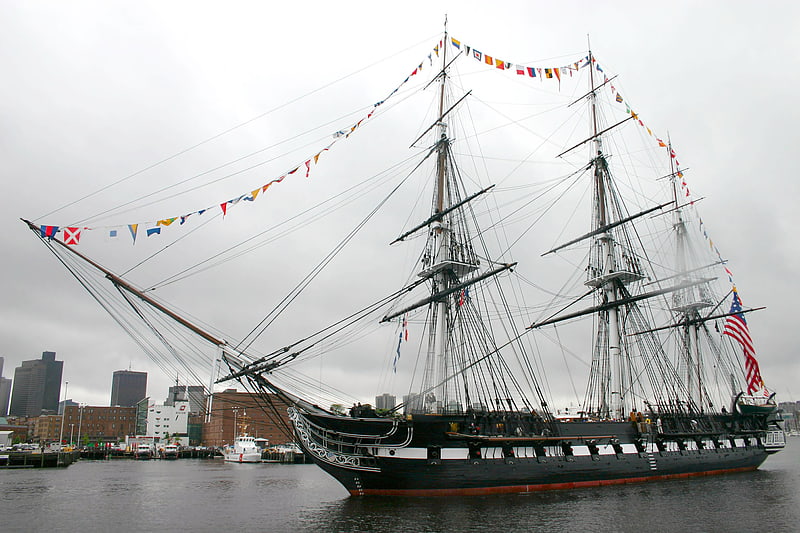
Ship. USS Constitution, also known as Old Ironsides, is a three-masted wooden-hulled heavy frigate of the United States Navy. She is the world's oldest ship of any type still afloat. She was launched in 1797, one of six original frigates authorized for construction by the Naval Act of 1794 and the third constructed. The name "Constitution" was among ten names submitted to President George Washington by Secretary of War Timothy Pickering in March of 1795 for the frigates that were to be constructed. Joshua Humphreys designed the frigates to be the young Navy's capital ships, and so Constitution and her sister ships were larger and more heavily armed and built than standard frigates of the period. She was built at Edmund Hartt's shipyard in the North End of Boston, Massachusetts. Her first duties were to provide protection for American merchant shipping during the Quasi-War with France and to defeat the Barbary pirates in the First Barbary War.
Constitution is most noted for her actions during the War of 1812 against the United Kingdom, when she captured numerous merchant ships and defeated five British warships: HMS Guerriere, Java, Pictou, Cyane, and Levant. The battle with Guerriere earned her the nickname "Old Ironsides" and public adoration that has repeatedly saved her from scrapping. She continued to serve as flagship in the Mediterranean and African squadrons, and she circled the world in the 1840s. During the American Civil War, she served as a training ship for the United States Naval Academy. She carried American artwork and industrial displays to the Paris Exposition of 1878.
Constitution was retired from active service in 1881 and served as a receiving ship until being designated a museum ship in 1907. In 1934, she completed a three-year, 90-port tour of the nation. She sailed under her own power for her 200th birthday in 1997, and again in August 2012 to commemorate the 200th anniversary of her victory over Guerriere.
Constitution's stated mission today is to promote understanding of the Navy's role in war and peace through educational outreach, historical demonstration, and active participation in public events as part of the Naval History & Heritage Command. As she is a fully commissioned Navy ship, her crew of 75 officers and sailors participate in ceremonies, educational programs, and special events while keeping her open to visitors year round and providing free tours. The officers and crew are all active-duty Navy personnel, and the assignment is considered to be special duty. She is usually berthed at Pier 1 of the former Charlestown Navy Yard at one end of Boston's Freedom Trail.[10]
Address: Bldg. 5, Charlestown Navy Yard, 02129 Boston (Charlestown)
Edward M. Kennedy Institute for the United States Senate
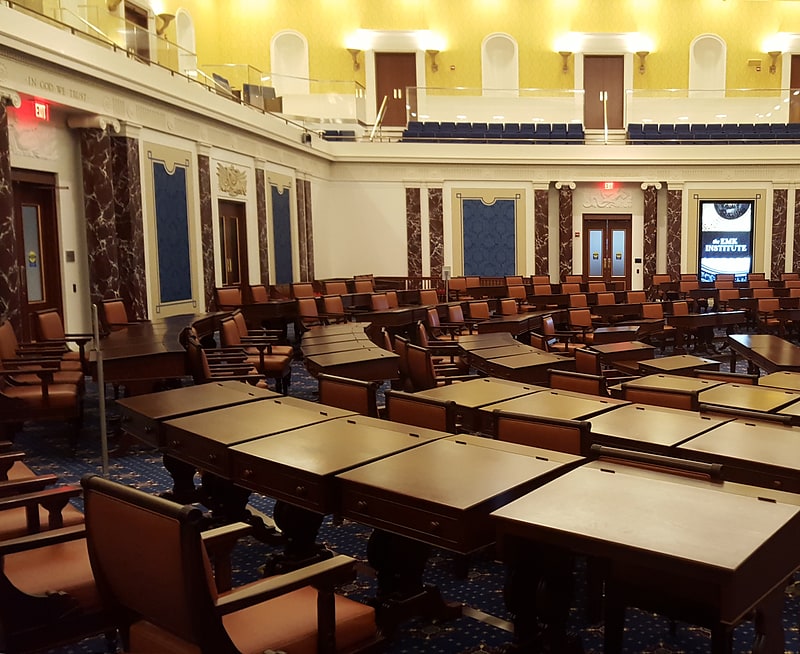
Museum in Boston, Massachusetts. The Edward M. Kennedy Institute for the United States Senate is a non-profit civic engagement and educational institution on Columbia Point in the Dorchester neighborhood of Boston, Massachusetts, next to the John F. Kennedy Presidential Library and Museum on the University of Massachusetts Boston campus. Named for long-time U.S. Senator Ted Kennedy, the Institute contains a full-scale reproduction of the United States Senate Chamber, a replica of Kennedy’s Washington, D.C. office, and digital exhibits. The organization includes the Kennedy Home in Hyannis Port, which was donated to the Institute in 2012 as part of a "mission of educating the public about the U.S. government, invigorating public discourse, emphasizing the importance of bipartisanship, and inspiring the next generation of citizens and leaders to engage in the public square."[11]
Address: 210 Morrissey Blvd, 02125 Boston (Dorchester)
Bunker Hill Monument
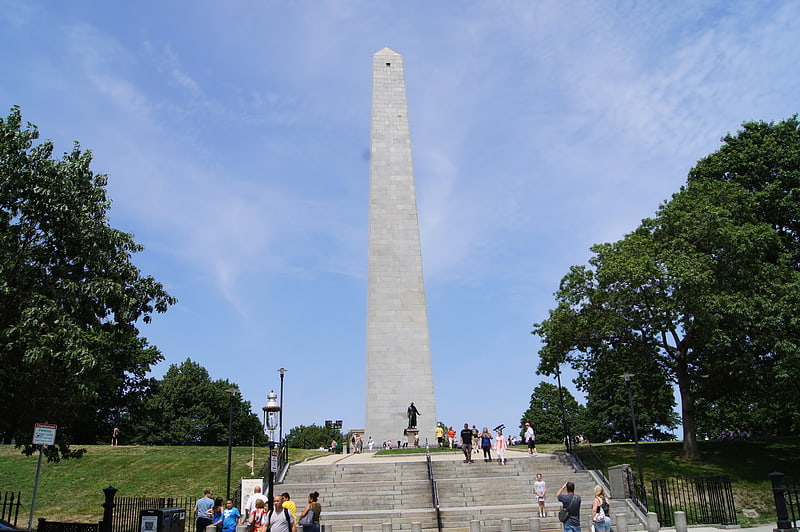
Granite obelisk on the Freedom Trail. The Bunker Hill Monument is a monument erected at the site of the Battle of Bunker Hill in Boston, Massachusetts, which was among the first major battles between the Red Coats and Patriots in the American Revolutionary War. The 221-foot granite obelisk was erected between 1825 and 1843 in Charlestown, Massachusetts, with granite from nearby Quincy conveyed to the site via the purpose-built Granite Railway, followed by a trip by barge. There are 294 steps to the top.
An exhibit lodge built near the base of the monument in the late 19th century houses a statue of fallen hero Dr. Joseph Warren. Bunker Hill is one of the sites along the Freedom Trail and is part of Boston National Historical Park.
The monument underwent a $3.7 million renovation, completed in 2007, that included repairs, handicap accessibility improvements, and new lighting. The Bunker Hill Museum across the street was dedicated in June of that year and includes many exhibits about the battle. No admission charge applies to the museum or monument.[12]
Address: 43 Monument Sq, 02129 Charlestown (Charlestown)
Legoland Discovery Center Boston
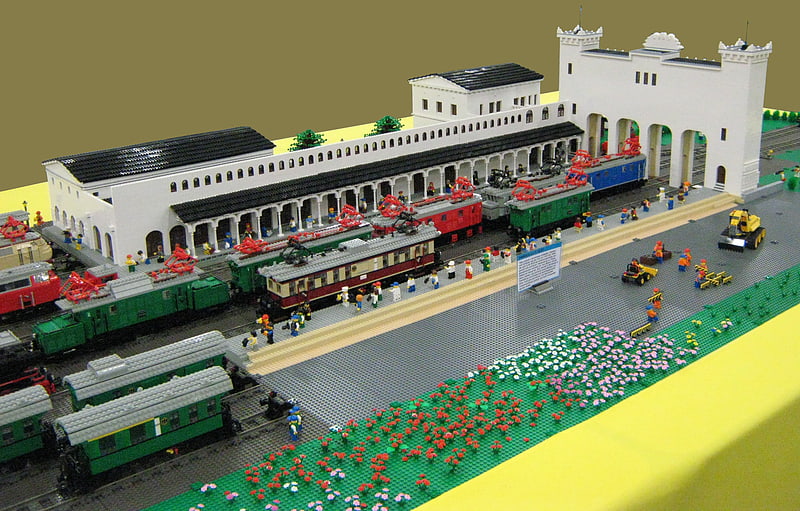
Amusement park in Somerville, Massachusetts. Legoland Discovery Center Boston is an indoor family entertainment center located in the Assembly Square neighborhood of Somerville, Massachusetts, near Boston. The popular attraction includes Lego rides, a soft play area, a 4D cinema and a gift shop. It also contains a mini Lego version of Boston, including mini replicas of the Gillette Stadium and Fenway Park. Legoland Discovery Center Boston is owned and operated by leisure group Merlin Entertainments.[13]
Address: 598 Assembly Row, 02145-4333 Somerville (Somerville)
Trinity Church
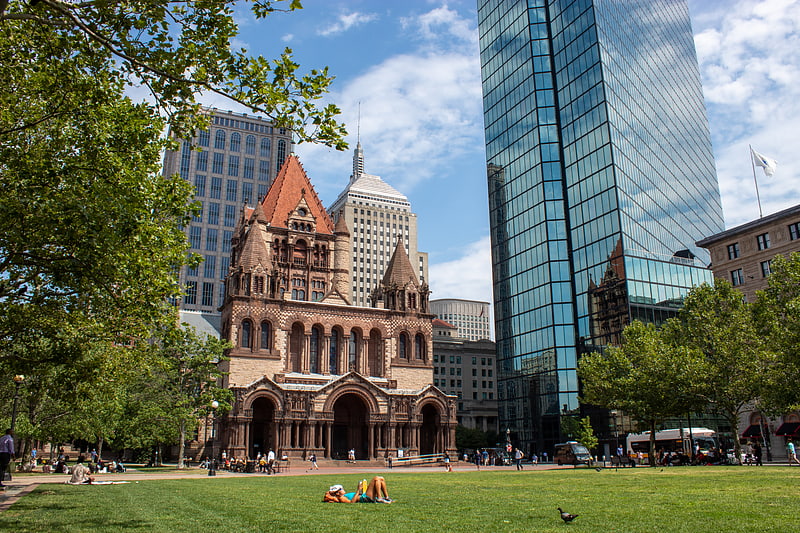
Church in Boston, Massachusetts. Trinity Church in the City of Boston, located in the Back Bay neighborhood of Boston, Massachusetts, is a parish of the Episcopal Diocese of Massachusetts. The congregation, currently standing at approximately 4,000 households, was founded in 1733. Five services are offered each Sunday, and weekday services are offered three times a week from September through June. Within the spectrum of worship styles in the Anglican tradition, Trinity Church has historically been considered a Broad Church parish.
In addition to worship, the parish is actively involved in service to the community, pastoral care, programs for children and teenagers, and Christian education for all ages. The church is home to several high-level choirs, including the Trinity Choir, Trinity Schola, Trinity Choristers, and Trinity Chamber Choir. The building, designed by Henry Hobson Richardson, is currently under study for becoming a Boston Landmark.[14]
Address: 206 Clarendon St, 02116 Boston
Downtown Crossing

Downtown Crossing is a shopping district within downtown Boston, Massachusetts, located east of Boston Common, west of the Financial District, south of Government Center, and north of Chinatown and the old Combat Zone. It features large department stores as well as restaurants, souvenir sellers, general retail establishments, and street vendors. The Downtown Crossing MBTA station lies in the center of the district.
The district gets its name from the intersection of Washington Street with Winter and Summer Streets. Historically, the district was anchored by two department stores, Jordan Marsh and Filene's which stood opposite each other at the intersection. While both stores have since been bought by other chains and no longer exist, the district continues to be a major pedestrian shopping area, with the area of Washington, Winter, and Summer streets surrounding the intersection closed to most vehicular traffic; pedestrians may walk freely in the street.[15]
Address: Washington Street, 02111 Boston
Haymarket Open-Air Market
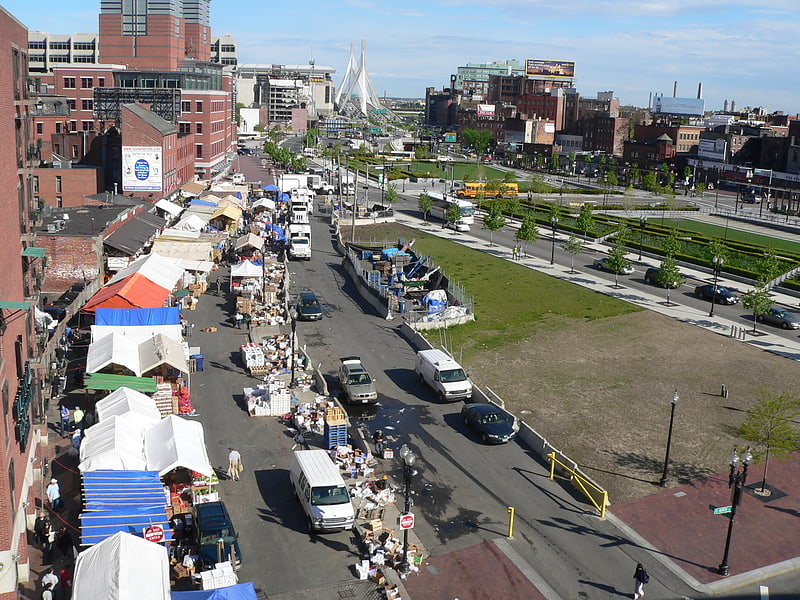
Produce market in Boston, Massachusetts. Haymarket in Boston is an open-air market on Blackstone, Hanover, and North Streets, next to the Rose Fitzgerald Kennedy Greenway between the North End and Government Center.
The market is operated by the Haymarket Pushcart Association. The association traces its history to 1820, and formally organized in 1974 to negotiate with the city on issues such as waste removal and traffic. The roughly 50 Haymarket vendors sell fruit, vegetables, and seafood at very low prices. The market offers "produce its vendors obtain from wholesale distribution terminals north of Boston," primarily the New England Produce Center in Chelsea. Prices are low because the wholesale markets need to make room for new shipments arriving over the weekend.
The market is open from 6AM to 7PM every Friday and Saturday. On Saturday nights nearing the 7 pm closing deadline, vendors often liquidate any remaining inventory selling whatever they have left for pennies on the dollar. The market's location and days of operation were established by a 1952 state law and by a 1978 city ordinance. Vendors are licensed by the City of Boston Inspectional Services Department.
The market is adjacent to the Haymarket MBTA station, which is served by two subway lines and many bus routes. Inexpensive validated parking for Haymarket shoppers is available at the Parcel 7 Garage. The discount was created as a "mitigation" measure for the impact of the Big Dig highway project on Haymarket.
A study conducted for the Boston Redevelopment Authority in 2009 by the Project for Public Spaces found that "Haymarket attracts one of the most diverse populations of any market we have worked on... Customers include almost every imaginable ethnic group and income level. Haymarket is the primary place where most of its shoppers buy produce and it serves a vital role in the Boston food distribution system." In 2015, two Johns Hopkins University graduate students proposed the creation in Baltimore of a market modeled after Haymarket, to address the problems of food going to waste and the lack of access to fresh produce in low-income communities.[16]
Address: 106 Blackstone St, 02109-1506 Boston
Rose Fitzgerald Kennedy Greenway
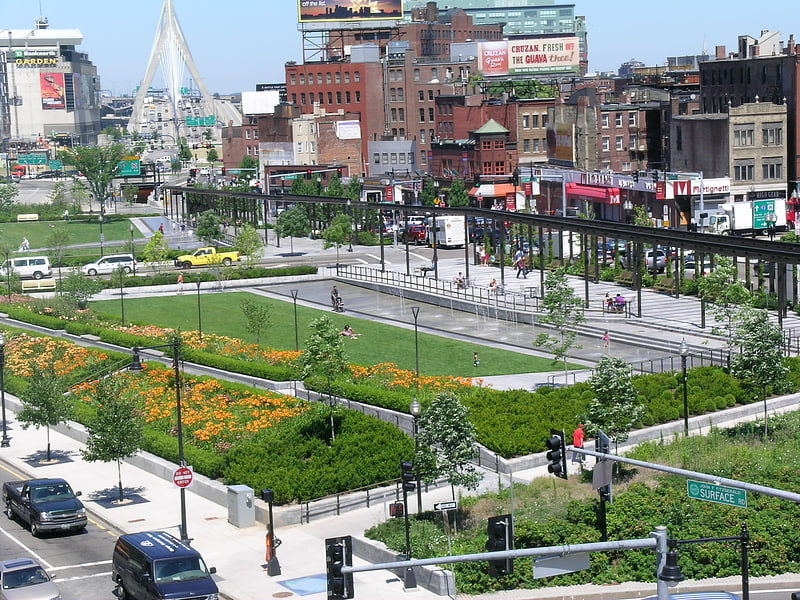
Park in Boston, Massachusetts. The Rose Fitzgerald Kennedy Greenway is a linear park located in several Downtown Boston neighborhoods. It consists of landscaped gardens, promenades, plazas, fountains, art, and specialty lighting systems that stretch over one mile through Chinatown, the Financial District, the Waterfront, and North End neighborhoods. Officially opened in October 2008, the 17-acre Greenway sits on land created from demolition of the John F. Fitzgerald Expressway under the Big Dig.
The Rose Fitzgerald Kennedy Greenway is named after Rose Fitzgerald Kennedy, the matriarch of the Kennedy Family who was born in the neighboring North End neighborhood. Her son, Senator Edward M. Kennedy, played an important role in establishing the Greenway.
The Rose Fitzgerald Kennedy Greenway Conservancy was established as an independently incorporated non-profit organization in 2004 to guide the emerging park system and raise funds for an endowment and operations. In 2008, the State Legislature confirmed the Conservancy as the designated steward of the Rose Kennedy Greenway; the Conservancy operates with a lease from the Massachusetts Turnpike Authority (now Massachusetts Department of Transportation). Since February 2009, the Conservancy has operated the park, leading the maturation of this new civic space, strengthening its physical beauty, and encouraging a sense of a shared community in Boston.
The 2008 legislation established a 50%-50% public/private funding model. Through a multi-party funding agreement announced in June 2017, public funds from the State and City represent ~20% of the operating budget, a new Greenway Business Improvement District funds ~20% of the operating budget, and the Greenway Conservancy generates ~60%.[17]
Address: JFK Surface Road, 02111 Boston
Isabella Stewart Gardner Museum
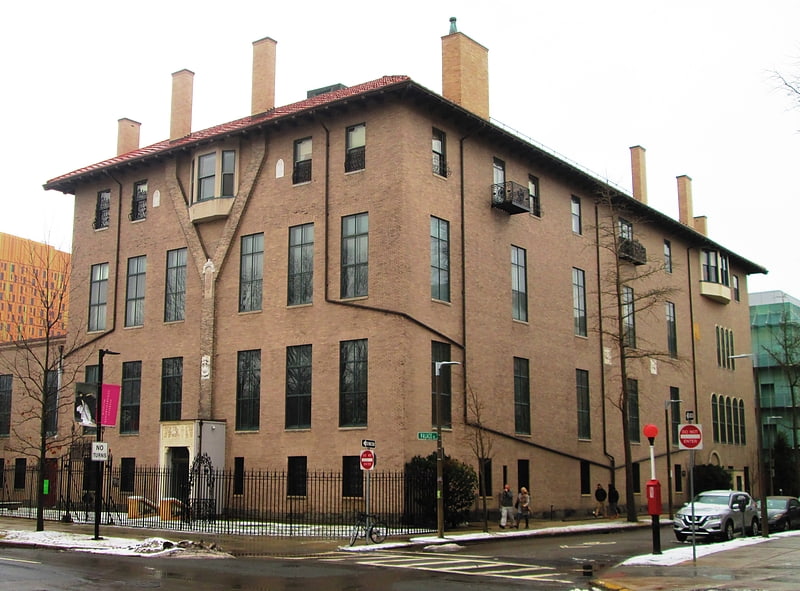
Art treasures in a Venetian-style palace. The Isabella Stewart Gardner Museum is an art museum in Boston, Massachusetts, which houses significant examples of European, Asian, and American art. Its collection includes paintings, sculpture, tapestries, and decorative arts. It was founded by Isabella Stewart Gardner, whose will called for her art collection to be permanently exhibited "for the education and enjoyment of the public forever".
An auxiliary wing, adjacent to the original structure near the Back Bay Fens, was completed in 2012.
In 1990, thirteen of the museum's works were stolen; the crime remains unsolved, and the works, valued at an estimated $500 million, have not been recovered. A $10 million reward for information leading to the art's recovery remains in place.[18]
Address: 25 Evans Way, 02115 Boston
Charles River Esplanade
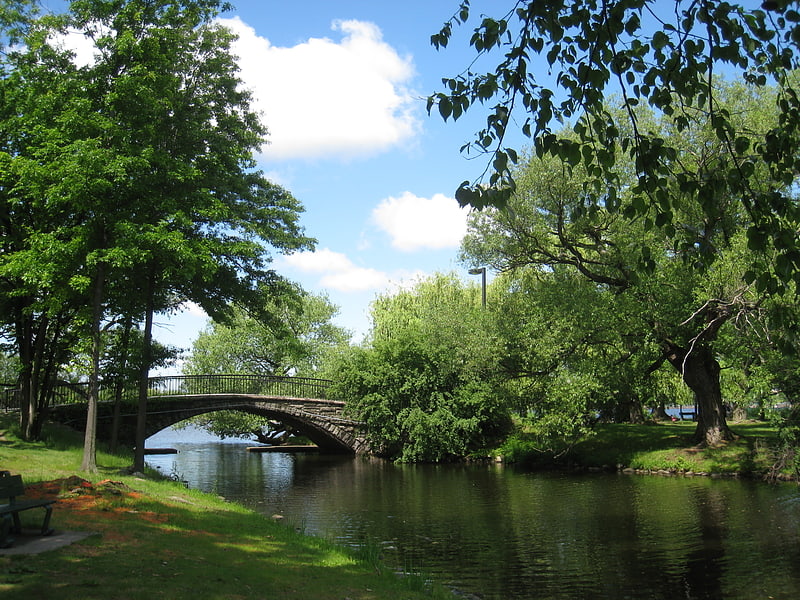
Park in Boston, Massachusetts. The Charles River Esplanade of Boston, Massachusetts, is a state-owned park situated in the Back Bay area of the city, on the south bank of the Charles River Basin.[19]
John F. Kennedy Presidential Library and Museum
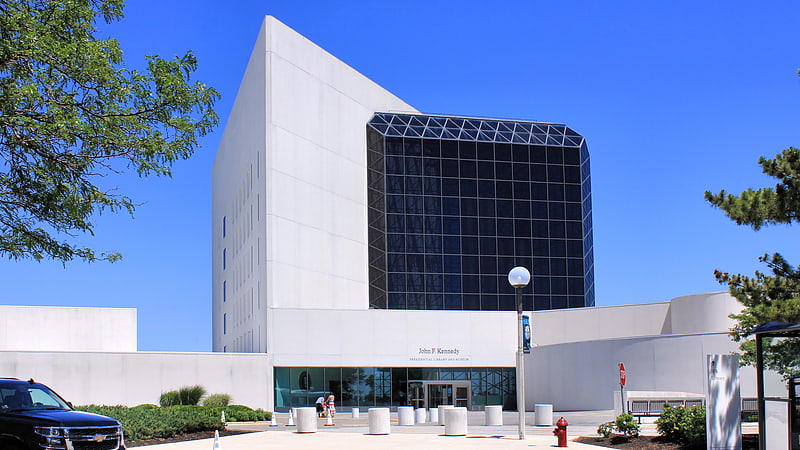
Political-history exhibits and artifacts. The John F. Kennedy Presidential Library and Museum is the presidential library and museum of John Fitzgerald Kennedy, the 35th president of the United States. It is located on Columbia Point in the Dorchester neighborhood of Boston, Massachusetts, next to the University of Massachusetts at Boston, the Edward M. Kennedy Institute for the United States Senate, and the Massachusetts Archives and Commonwealth Museum. Designed by the architect I. M. Pei, the building is the official repository for original papers and correspondence of the Kennedy Administration, as well as special bodies of published and unpublished materials, such as books and papers by and about Ernest Hemingway.
The library and museum is part of the Presidential Library System, which is administered by the Office of Presidential Libraries, a part of the National Archives and Records Administration (NARA).
The library and Museum were dedicated in 1979 by President Jimmy Carter and members of the Kennedy family. It can be reached from nearby Interstate 93 or via shuttle bus or walk from the JFK/UMass stop on the Red Line of Boston's MBTA system.[20]
Address: Columbia Point, 02125 Boston (Dorchester)
Granary Burying Ground
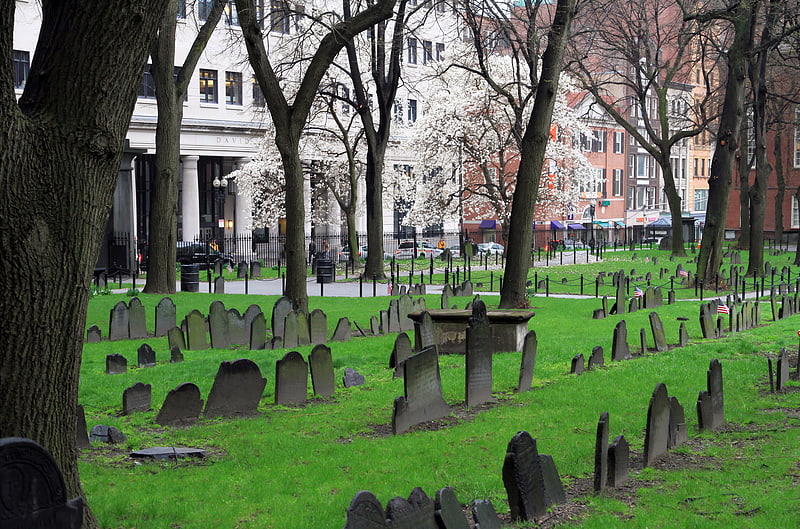
Historic cemetery on the Freedom Trail. The Granary Burying Ground in Massachusetts is the city of Boston's third-oldest cemetery, founded in 1660 and located on Tremont Street. It is the final resting place for many notable Revolutionary War-era patriots, including Paul Revere, the five victims of the Boston Massacre, and three signers of the Declaration of Independence: Samuel Adams, John Hancock, and Robert Treat Paine. The cemetery has 2,345 grave-markers, but historians estimate that as many as 5,000 people are buried in it. The cemetery is adjacent to Park Street Church, behind the Boston Athenaeum and immediately across from Suffolk University Law School. It is a site on Boston's Freedom Trail.
The cemetery's Egyptian revival gate and fence were designed by architect Isaiah Rogers (1800–1869), who designed an identical gate for Newport's Touro Cemetery.[21]
Address: Tremont Street, 02108 Boston
Institute of Contemporary Art
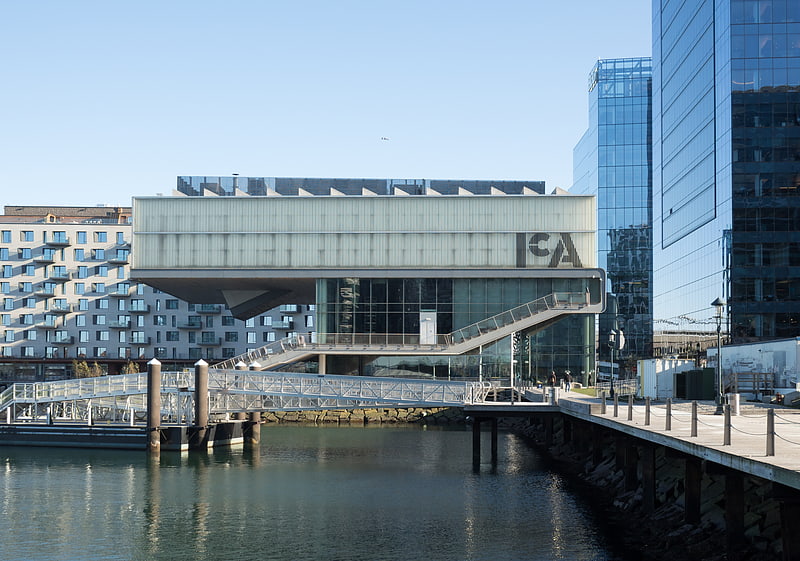
The Institute of Contemporary Art is an art museum and exhibition space located in Boston, Massachusetts, United States of America. The museum was founded as the Boston Museum of Modern Art in 1936. Since then it has gone through multiple name changes as well as moving its galleries and support spaces over 13 times. Its current home was built in 2006 in the South Boston Seaport District and designed by architects Diller Scofidio + Renfro.[22]
Address: 25 Harbor Shore Drive, 02210 Boston (South Boston)
Harvard Art Museums
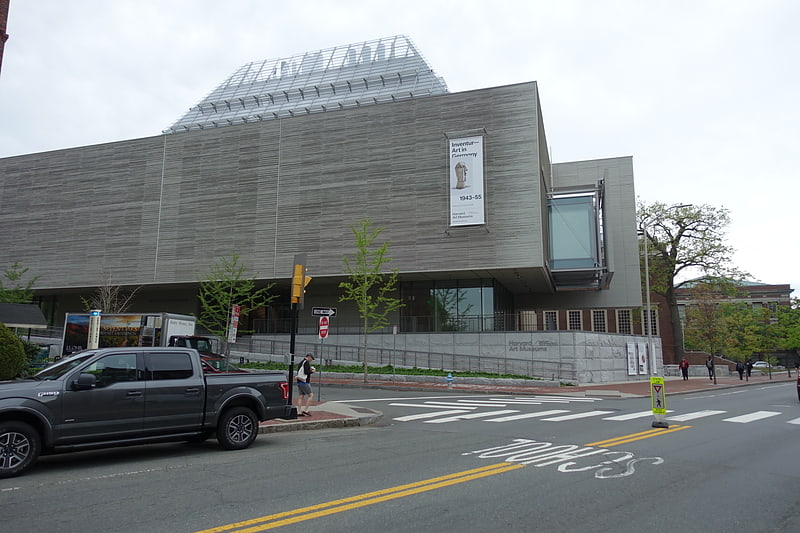
Diverse European and American works. The Harvard Art Museums are part of Harvard University and comprise three museums: the Archaeological Exploration of Sardis, the Fogg Museum, the Busch-Reisinger Museum, and the Arthur M. Sackler Museum and four research centers: the Center for the Technical Study of Modern Art, the Harvard Art Museums Archives, and the Straus Center for Conservation and Technical Studies. The three museums that constitute the Harvard Art Museums were initially integrated into a single institution under the name Harvard University Art Museums in 1983. The word "University" was dropped from the institutional name in 2008.
The collections include approximately 250,000 objects in all media, ranging in date from antiquity to the present and originating in Europe, North America, North Africa, the Middle East, South Asia, East Asia, and Southeast Asia. The main building contains 204,000 square feet (19,000 m2) of space for public exhibitions, classrooms, conservation and research labs, and other related functions. Approximately 43,000 square feet (4,000 m2) of space are dedicated to exhibitions.[23]
Address: 32 Quincy St, 02138-3847 Cambridge (Cambridge)
Paul Revere House
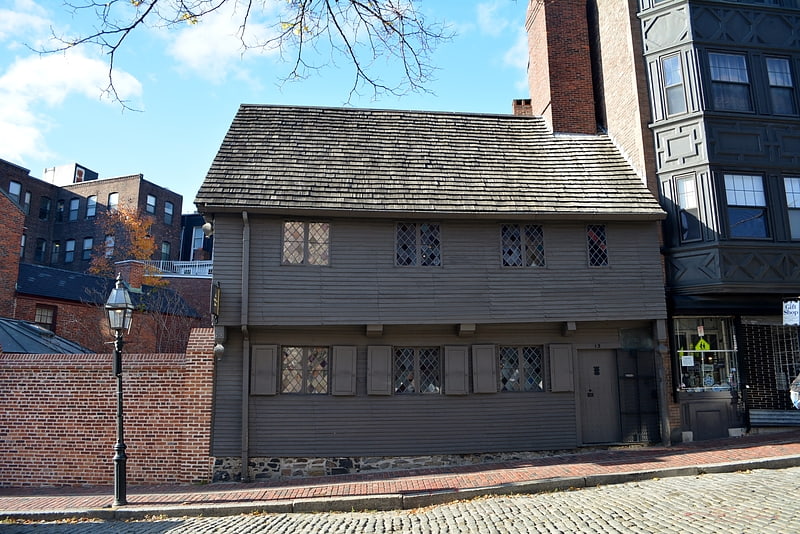
Revolutionary War hero's famed residence. The Paul Revere House, built c.1680, was the colonial home of American patriot Paul Revere during the time of the American Revolution. A National Historic Landmark since 1961, it is located at 19 North Square, Boston, Massachusetts, in the city's North End, and is now operated as a nonprofit museum by the Paul Revere Memorial Association. An admission fee is charged.[24]
Address: 19 N Square, 02113 Boston
Copley Square
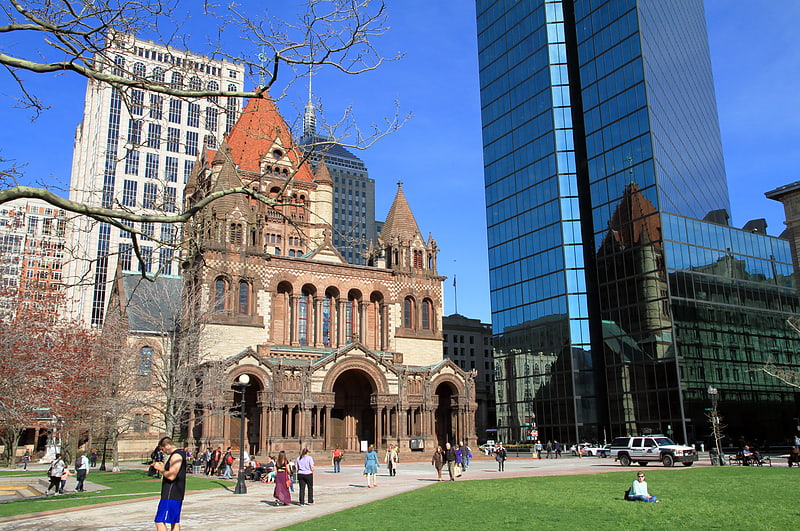
Copley Square, named for painter John Singleton Copley, is a public square in Boston's Back Bay neighborhood, bounded by Boylston Street, Clarendon Street, St. James Avenue, and Dartmouth Street. Prior to 1883 it was known as Art Square due to its many cultural institutions, some of which remain today. It was proposed as a Boston Landmark.[25]
Address: 158 Newbury St, 02116 Boston
Boston City Hall
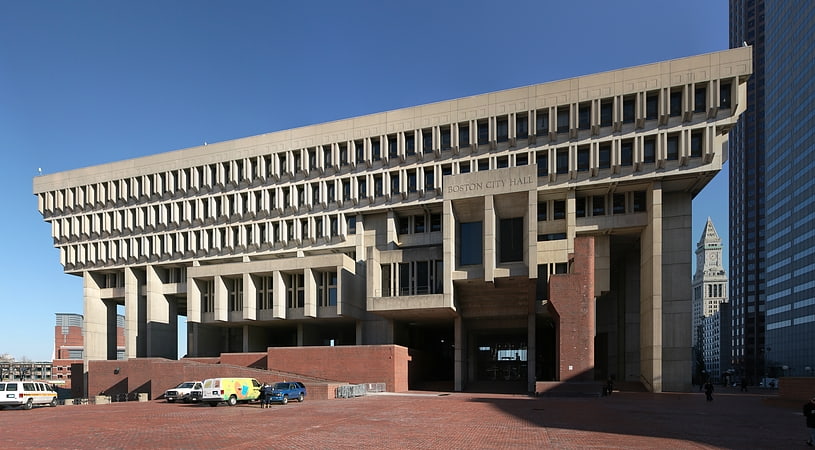
Multi-level concrete space for events. Boston City Hall is the seat of city government of Boston, Massachusetts. It includes the offices of the mayor of Boston and the Boston City Council. The current hall was built in 1968 to assume the functions of the Old City Hall.
It is a controversial and prominent example of Brutalist architecture, part of the modernist movement. It was designed by the architecture firms Kallmann McKinnell & Knowles and Campbell, Aldrich & Nulty, with LeMessurier Consultants as engineers.
Together with the surrounding plaza, City Hall is part of the Government Center complex. This project constituted a major urban redesign effort in the 1960s, as Boston demolished an area of substandard housing and businesses.
The building has been subject to widespread public condemnation, and is sometimes called one of the world's ugliest buildings. Calls for the structure to be demolished have been regularly made even before construction was finished. Architects and critics considered it to be excellent work, with one poll finding that professional architects describe Boston City Hall as one of the ten proudest achievements of American architecture.[26]
Address: 1 City Hall Sq, 02201-1020 Boston
Government Center
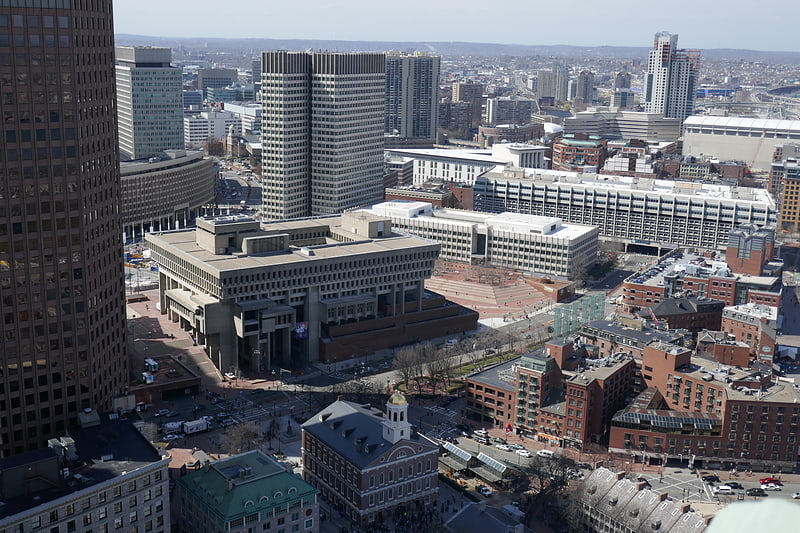
Government Center is an area in downtown Boston, centered on City Hall Plaza. Formerly the site of Scollay Square, it is now the location of Boston City Hall, courthouses, state and federal office buildings, and a major MBTA subway station, also called Government Center. Its development was controversial, as the project displaced thousands of residents and razed several hundred homes and businesses.
Controversial in design since before it was completed, the use of Brutalist architecture for its main buildings, as well as the open brick-and-concrete plaza at the center of the development, have been alternately praised for its innovative design, and scorned for its lack of character and uninviting appearance. After decades of calls for a redesign to make it more friendly and usable, a major rebuild of City Hall Plaza, the main public space of Government Center, was begun in 2020 and is to include additional seating areas, play spaces for children, and space for public art.[27]
Boston Public Garden Foot Bridge

Pedestrian bridge. The Boston Public Garden Foot Bridge is a pedestrian bridge crossing the lagoon in Boston Public Garden, in Boston, Massachusetts, United States. Built in 1867, it was the world's shortest functioning suspension bridge before its conversion to a girder bridge in 1921.
A plaque reads, "Public Garden / Foot Bridge / Opened June 1, 1867 / Designers / Clemens Herschel, Civil Engineer / 1842 - 1930 / William G. Preston, Architect / 1842 - 1910 / Tablet Placed June 1, 1936 / Boston Society of Civil Engineers".[28]
Massachusetts State House
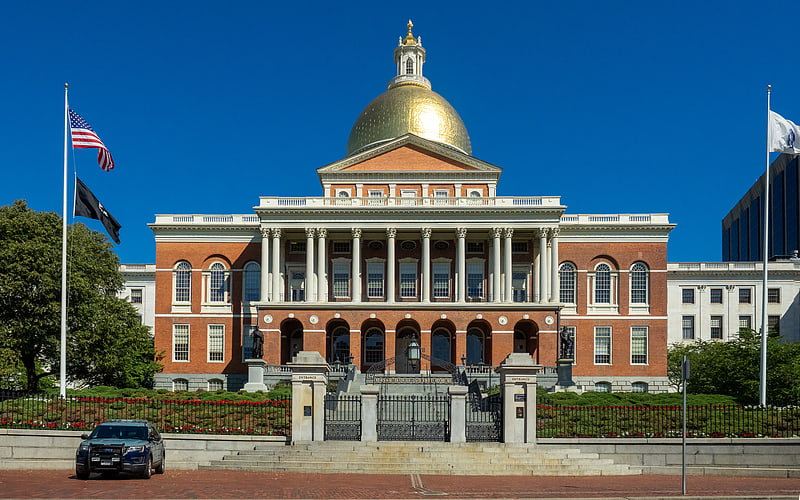
Federal-era home of state legislature. The Massachusetts State House, also known as the Massachusetts Statehouse or the New State House, is the state capitol and seat of government for the Commonwealth of Massachusetts, located in the Beacon Hill neighborhood of Boston. The building houses the Massachusetts General Court and the offices of the Governor of Massachusetts. The building, designed by architect Charles Bulfinch, was completed in January 1798 at a cost of $133,333, and has repeatedly been enlarged since. It is considered a masterpiece of Federal architecture and among Bulfinch's finest works, and was designated a National Historic Landmark for its architectural significance.[29]
Address: 24 Beacon St, 02133-1099 Boston
Harvard Stadium
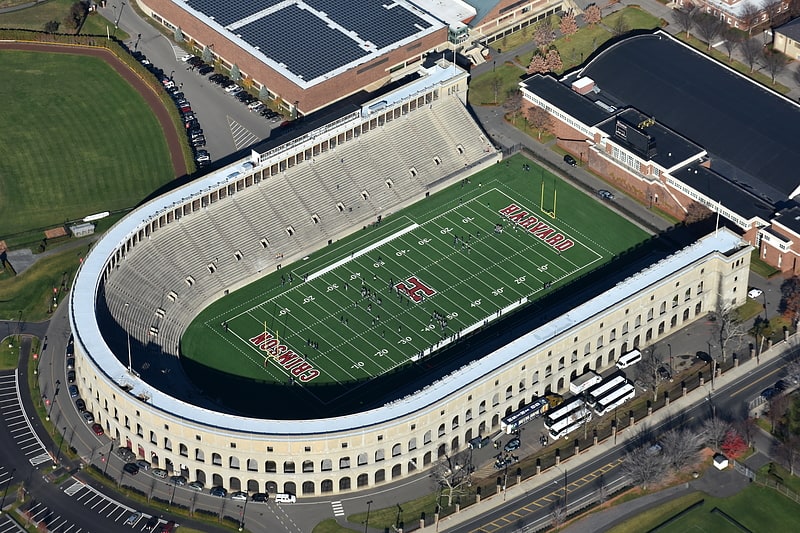
Stadium in Boston, Massachusetts. Harvard Stadium is a U-shaped college football stadium in the northeast United States, located in the Allston neighborhood of Boston, Massachusetts. The stadium is owned and operated by Harvard University and is home to the Harvard Crimson football program. The stadium's seating capacity is 30,323.
Built in 1903, it was a pioneering execution of reinforced concrete in the construction of large structures. Because of its early importance in these areas, and its influence on the design of later stadiums, it was designated a National Historic Landmark in 1987. The stadium is the nation's oldest permanent concrete structure dedicated to intercollegiate athletics. It seated up to 57,166 in the past, as permanent steel stands (completing a straight-sided oval) were installed in the stadium's northeast end zone in 1929. They were torn down after the 1951 season, due to deterioration and reduced attendance. Afterward, there were smaller temporary steel bleachers across the stadium's open end until the building of the Murr Center (which is topped by the new scoreboard) in 1998.
Harvard Stadium hosted one Boston Patriots season in 1970. It was their first season in the NFL after the AFL–NFL merger and their last before becoming the New England Patriots. The team moved to Schaefer Stadium in Foxborough the following season.[30]
Address: 79 N Harvard St, 02163-1010 Boston
Harvard Bridge
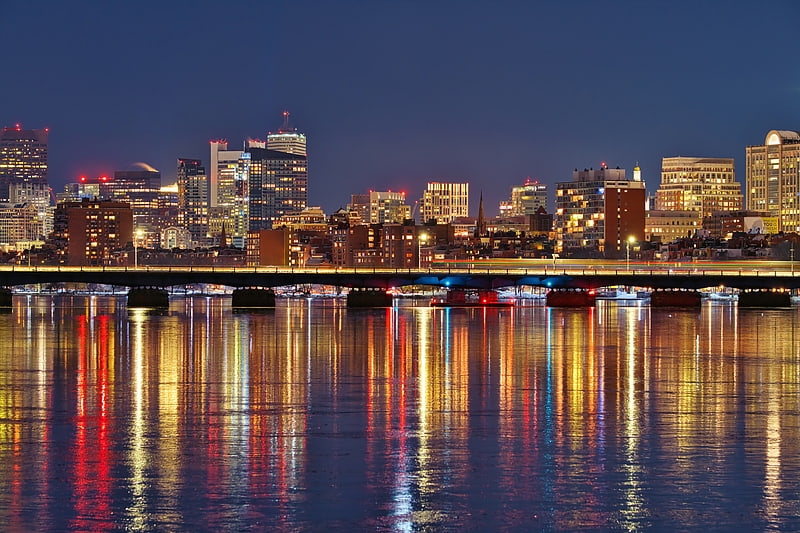
Girder bridge in Cambridge, Massachusetts. The Harvard Bridge is a steel haunched girder bridge carrying Massachusetts Avenue over the Charles River and connecting Back Bay, Boston with Cambridge, Massachusetts. It is the longest bridge over the Charles River at 2,164.8 feet.
After years of infighting between the cities of Boston and Cambridge, the bridge was built jointly by the two cities between 1887 and 1891. It was named for Harvard University founder John Harvard. Originally equipped with a central swing span, it was revised several times over the years until its superstructure was completely replaced in the late 1980s due to unacceptable vibration and the collapse of a similar bridge.
The bridge is known locally for being marked off in the idiosyncratic unit of length called the smoot.[31]
Old North Church
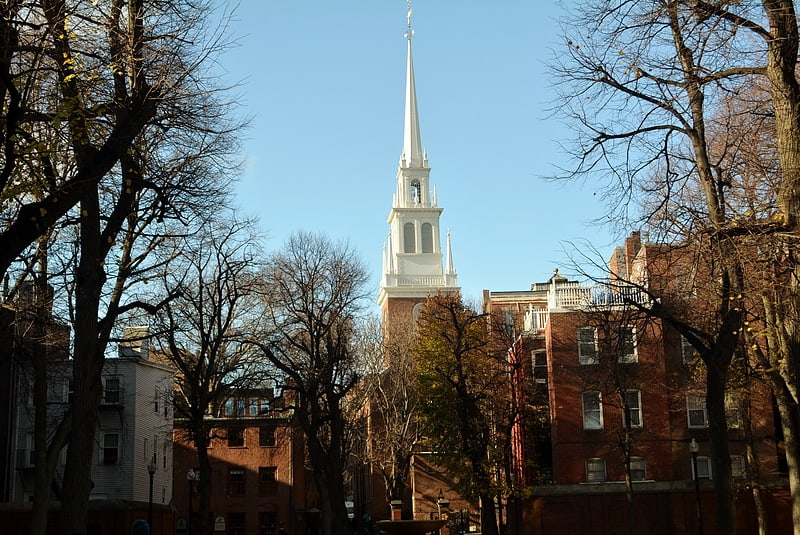
Launch point for Paul Revere's ride. Old North Church, at 193 Salem Street, in the North End, Boston, is the location from which the famous "One if by land, two if by sea" signal is said to have been sent. This phrase is related to Paul Revere's midnight ride of April 18, 1775, which preceded the Battles of Lexington and Concord during the American Revolution.
The church is a mission of the Episcopal Diocese of Massachusetts. It was built in 1723 and is the oldest standing church building in Boston and a National Historic Landmark. Inside the church is a bust of George Washington, which Gilbert du Motier, Marquis de Lafayette, reportedly remarked was the best likeness of the first president he had ever seen.[32]
Address: 193 Salem St, 02113-1123 Boston
Museum of Comparative Zoology
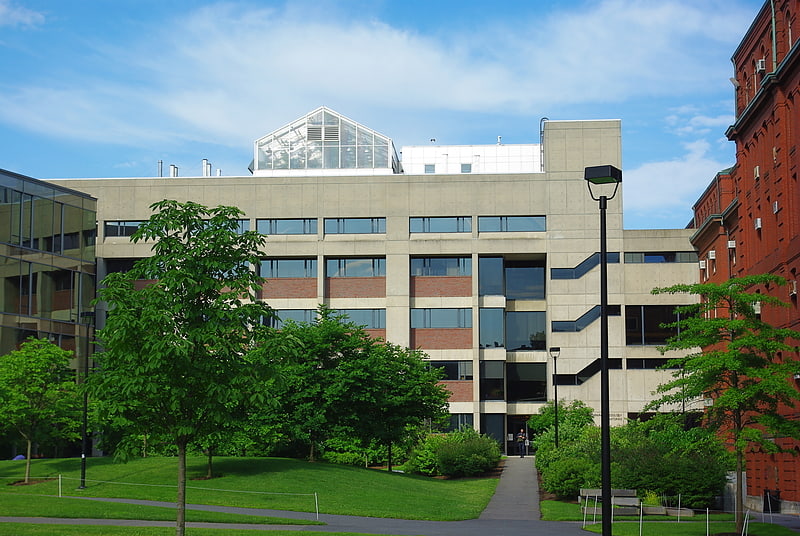
Museum in Cambridge, Massachusetts. The Museum of Comparative Zoology is a zoology museum located on the grounds of Harvard University in Cambridge, Massachusetts. It is one of three natural-history research museums at Harvard, whose public face is the Harvard Museum of Natural History. Harvard MCZ's collections consist of some 21 million specimens, of which several thousand are on rotating display at the public museum. The current director of the MCZ is James Hanken, the Louis Agassiz Professor of Zoology at Harvard.
Many of the exhibits in the public museum have not only zoological interest, but also historical significance. Past exhibits have included a fossil sand dollar found by Charles Darwin in 1834, Captain Cook's mamo, and two pheasants that once belonged to George Washington, now on loan to Mount Vernon in Virginia.
The Harvard Museum of Natural History is physically connected to the Peabody Museum of Archaeology and Ethnology; for visitors, one admission ticket grants access to both museums. The research collections of the MCZ are not open to the public.[33]
Address: 26 Oxford St, 02138-2902 Cambridge (Cambridge)
Matthews Arena
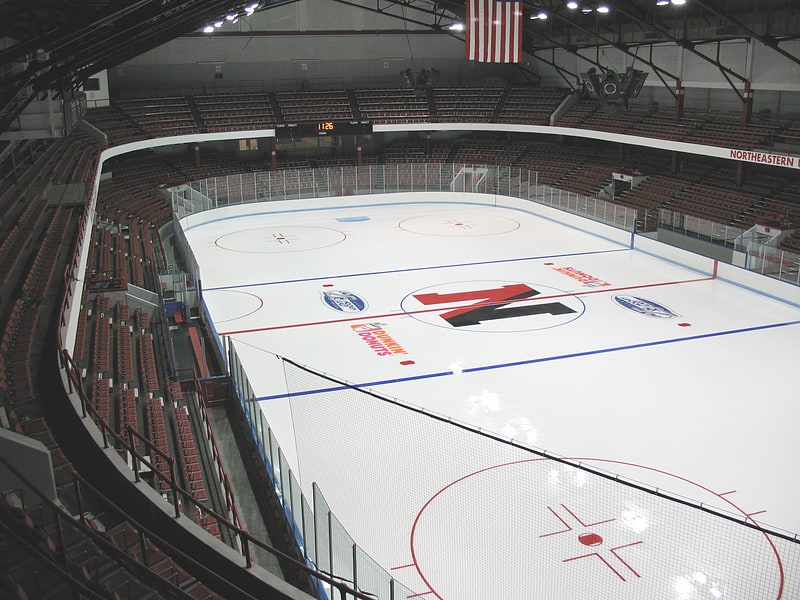
Arena in Boston, Massachusetts. Matthews Arena is a multi-purpose arena in Boston, Massachusetts. It is both the oldest arena still in use for ice hockey and the oldest multi-purpose athletic building still in use in the world.
It opened in 1910 on what is now the east end of Northeastern University's campus, and is currently owned by the university. It is the original home of the National Hockey League (NHL) Boston Bruins — the only team of the NHL's Original Six whose original home arena still exists for the sport of ice hockey at any level of competition — and the WHA New England Whalers (now the NHL Carolina Hurricanes), as well as the secondary home of the NBA Boston Celtics.
Today, Matthews Arena is home to the Northeastern Huskies men's and women's ice hockey teams, and men's basketball team as well as various high school ice hockey programs in the city of Boston. Matthews Arena also hosts a variety of Northeastern on-campus events, including the annual Springfest concert, as well as graduation ceremonies for the university.
The closest MBTA station is the Massachusetts Ave Orange Line subway station; the Green Line E branch's underground Symphony station is two blocks northwest.[34]
Address: 238 Saint Botolph St # 262, 02115-4909 Boston
Boston Navy Yard
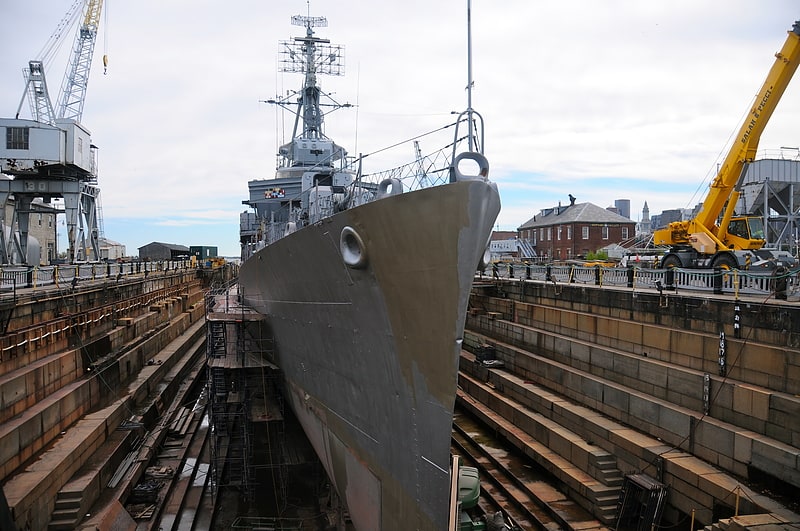
Naval base in Boston, Massachusetts. The Boston Navy Yard, originally called the Charlestown Navy Yard and later Boston Naval Shipyard, was one of the oldest shipbuilding facilities in the United States Navy. It was established in 1801 as part of the recent establishment of the new U.S. Department of the Navy in 1798. After 175 years of military service, it was decommissioned as a naval installation on 1 July 1974.
The 30-acre (12 ha) property is administered by the National Park Service, becoming part of Boston National Historical Park. Enough of the yard remains in operation to support the moored USS Constitution ("Old Ironsides") of 1797, built as one of the original six heavy frigates for the revived American navy, and the oldest warship still commissioned in the United States Navy and afloat in the world. USS Cassin Young (DD-793), a 1943 World War II-era Fletcher-class destroyer serving as a museum ship, is also berthed here. The museum area includes a dock which is a stop on the MBTA Boat water transport system. Among local people in the area and the National Park Service, it is still known as the Charlestown Navy Yard.
The South Boston Naval Annex was located along the waterfront in South Boston, an annex of the Navy Yard from 1920 to 1974. Other annexes of the Navy Yard during World War II were the Chelsea Naval Annex (formerly the Green Shipyard, now the Fitzgerald Shipyard), East Boston Naval Annex, and Boston Naval Yard Fuel Depot Annex.[35]
Address: First Ave., Boston (Charlestown)